Popular categories
Looking for a yarn?
The yarn cost is calculated from the pattern’s smallest size and the yarn’s cheapest product type. Looking for an even better price? You might find it on the DROPS Deals!
Sugar Glaze Vest
Knitted vest with double neck in DROPS Air. Sizes S - XXXL.
DROPS Design: Pattern no ai-358
Yarn group C or A + A
-------------------------------------------------------
SIZES:
S - M - L - XL - XXL - XXXL
MATERIALS:
DROPS AIR from Garnstudio (belongs to yarn group C)
250-300-300-350-350-400 g colour 01, off white
NEEDLES:
DROPS SINGLE POINTED NEEDLES SIZE 5 MM.
DROPS SINGLE POINTED NEEDLES SIZE 3 MM.
DROPS CIRCULAR NEEDLE SIZE 3 MM: Length 40-40-40-60-60-60 cm.
KNITTING TENSION:
17 stitches in width and 22 rows in height with stocking stitch = 10 x 10 cm.
NOTE: Needle size is only a guide. If you get too many stitches on 10 cm, change to a larger needle size. If you get too few stitches on 10 cm, change to a smaller needle size.
-------------------------------------------------------
Alternative Yarn – See how to change yarns here
Yarn Groups A to F – Use the same pattern and change the yarn here
Yarn usage using an alternative yarn – Use our yarn converter here
-------------------------------------------------------
The yarn cost is calculated from the pattern’s smallest size and the yarn’s cheapest product type. Looking for an even better price? You might find it on the DROPS Deals!
- English (UK/cm), Bulgaria
- Česky
- Dansk
- Deutsch
- Eesti keel
- English (UK/cm)
- English (US/in)
- Español
- Français
- Íslenska
- Italiano
- Magyar
- Nederlands
- Norsk
- Polski
- Português
- Suomi
- Svenska
- English (UK/cm), Croatia
- English (UK/cm), Greece
- English (UK/cm), Latvia
- English (UK/cm), Lithuania
- English (UK/cm), Romania
- English (UK/cm), Slovenia
- Česky, Slovakia
Pattern instructions
EXPLANATIONS FOR THE PATTERN:
-------------------------------------------------------
RIDGE/GARTER STITCH (worked back and forth):
Knit all rows.
1 ridge = knit 2 rows.
PATTERN:
See diagram A.1. The diagram shows all rows in the pattern from the right side.
DECREASE TIP-1 (evenly spaced):
To work out how to decrease evenly, count the total number of stitches on needle (e.g. 112 stitches) minus the edge stitches (e.g. 2 stitches) and divide the remaining stitches by the number of decreases to be made (e.g. 32) = 3.4.
In this example decrease by knitting together alternately each 2nd and 3rd stitch and each 3rd and 4th stitch (approx.).
DECREASE TIP-2 (armholes and neck):
All decreases are worked from the right side!
DECREASE AT THE BEGINNING OF THE ROW:
Work 1 edge stitch in garter stitch, knit 2, slip 1 stitch as if to knit, knit 1 and pass the slipped stitch over the knitted stitch (= 1 stitch decreased).
DECREASE AT THE END OF THE ROW:
Work until there are 5 stitches left, knit 2 together (= 1 stitch decreased), knit 2 and 1 edge stitch in garter stitch.
CASTING-OFF TIP:
To avoid the cast-off edge being tight you can cast off with a larger size needle. If the edge is still tight, make 1 yarn over after approx. each 4th stitch at the same time as casting off; the yarn overs are cast off as normal stitches.
-------------------------------------------------------
START THE PIECE HERE:
-------------------------------------------------------
VEST – SHORT OVERVIEW OF THE PIECE:
The back and front pieces are worked separately, back and forth, then sewn together. Ribbed edges are worked around the neck and the armholes to finish.
BACK PIECE:
Cast on 112-120-132-142-156-170 stitches (including 1 edge stitch on each side) with needle size 3 mm and DROPS Air. Purl 1 row from the wrong side. Then work rib as follows:
1 edge stitch in GARTER STITCH – read description above, work A.1 until there is 1 stitch left, 1 edge stitch in garter stitch. Continue this rib back and forth for 8 cm – adjust so the next row is from the right side.
Knit 1 row where you decrease 32-34-38-40-44-48 stitches evenly spaced – read DECREASE TIP-1 = 80-86-94-102-112-122 stitches.
Change to needle size 5 mm. Purl 1 row with 1 edge stitch in garter stitch on each side. Continue with stocking stitch and 1 edge stitch in garter stitch on each side. REMEMBER THE KNITTING TENSION!
When the piece measures 22-23-24-25-26-27 cm, cast off 4-4-5-5-6-7 stitches for the armholes at the beginning of the next 2 rows = 72-78-84-92-100-108 stitches.
On the next row from the right side decrease 1 stitch on each side for the armholes – read DECREASE TIP-2.
Decrease like this every 2nd row (each row from the right side) a total of 2-3-3-5-7-8 times, then every 4th row (every other row from the right side) 6-6-7-8-8-9 times = 56-60-64-66-70-74 stitches.
When the piece measures 48-50-52-54-56-58 cm, cast off the middle 30-32-34-34-36-36 stitches for the neck from the right side and finish each shoulder separately.
LEFT SHOULDER (when the garment is worn):
Continue with stocking stitch and 1 edge stitch in garter stitch on each side.
AT THE SAME TIME on the next row from the right side decrease 1 stitch at the beginning of the row – remember DECREASE TIP-2 = 12-13-14-15-16-18 stitches. Continue until the piece measures 50-52-54-56-58-60 cm. Loosely cast off with knit from the right side.
RIGHT SHOULDER:
Continue with stocking stitch and 1 edge stitch in garter stitch on each side.
AT THE SAME TIME on the next row from the right side decrease 1 stitch at the end of the row – remember DECREASE TIP-2 = 12-13-14-15-16-18 stitches. Continue until the piece measures 50-52-54-56-58-60 cm. Loosely cast off with knit from the right side.
FRONT PIECE:
Cast on 112-120-132-142-156-170 stitches (including 1 edge stitch on each side) with needle size 3 mm and DROPS Air. Purl 1 row from the wrong side. Then work rib as follows:
1 edge stitch in garter stitch, work A.1 until there is 1 stitch left, 1 edge stitch in garter stitch. Continue this rib back and forth for 8 cm – adjust so the next row is from the right side.
Knit 1 row where you decrease 32-34-38-40-44-48 stitches evenly spaced – remember DECREASE TIP-1 = 80-86-94-102-112-122 stitches.
Change to needle size 5 mm. Purl 1 row with 1 edge stitch in garter stitch on each side. Continue with stocking stitch and 1 edge stitch in garter stitch on each side.
When the piece measures 22-23-24-25-26-27 cm, cast off 4-4-5-5-6-7 stitches for the armholes at the beginning of the next 2 rows = 72-78-84-92-100-108 stitches.
On the next row from the right side decrease 1 stitch on each side for the armholes.
Decrease like this every 2nd row (each row from the right side) a total of 2-3-3-5-7-8 times, then every 4th row (every other row from the right side) 6-6-7-8-8-9 times = 56-60-64-66-70-74 stitches.
When the piece measures 41-43-44-46-47-49 cm, place the middle 16-18-20-20-22-22 stitches on a thread for the neck, working from the right side, and finish each shoulder separately.
RIGHT SHOULDER (when the garment is worn):
Continue with stocking stitch and 1 edge stitch in garter stitch on each side.
AT THE SAME TIME on the next row from the right side decrease 1 stitch at the beginning of the row. Decrease like this every 2nd row (every row from the right side) a total of 8 times = 12-13-14-15-16-18 stitches. Continue until the piece measures 50-52-54-56-58-60 cm. Loosely cast off with knit from the right side.
LEFT SHOULDER:
Continue with stocking stitch and 1 edge stitch in garter stitch on each side.
AT THE SAME TIME on the next row from the right side decrease 1 stitch at the end of the row. Decrease like this every 2nd row (every row from the right side) a total of 8 times = 12-13-14-15-16-18 stitches. Continue until the piece measures 50-52-54-56-58-60 cm. Loosely cast off with knit from the right side.
ASSEMBLY:
Sew the shoulder seams inside the cast-off edge.
Sew the side seams from the armhole down, inside the 1 edge stitch.
DOUBLE NECK:
Using circular needle size 3 mm and starting from the right side on the one shoulder, knit up 100-104-112-112-118-118 stitches (including the stitches from the thread) around the neck, inside the 1 edge stitch. The number of stitches should be divisible by 2. Work A.1 in the round for 9-9-9-10-10-10 cm. Cast off with knit over knit and purl over purl – read CASTING-OFF TIP!.
Fold the neck double to the inside and sew down. To avoid the neck being tight, it is important that the seam is elastic.
SLEEVE-EDGES:
Use circular needle size 3 mm and DROPS Air. Start from the right side at the bottom of the armhole and knit up 118-122-126-130-134-138 stitches around the armhole inside the 1 edge stitch. The number of stitches should be divisible by 2. Work A.1 in the round for 4 cm. Cast off with knit over knit and purl over purl – remember CASTING-OFF TIP!.
Work the other sleeve-edge in the same way.
Diagram

|
= knit twisted from right side, purl twisted from wrong side |

|
= purl from right side, knit from wrong side |

What can you do with our patterns? You can share DROPS patterns online, using the pattern original picture, materials, name and number. But you are NOT ALLOWED to reproduce the complete pattern digitally in any way. Yarn stores are welcome to use the DROPS pattern database to promote the sale of our assortment. You can print out our patterns, make as many copies as you’d like. The only thing we ask is that you don't make any changes / additions to the original printed document. And that the patterns according to the DROPS philosophy are given out to the consumers for free. Editorials that wish to publish our patterns in printed books or magazines can contact us for more information. The sale of garments based on DROPS patterns is permitted as long as they are sold as single items or per order. Further commercial use of the patterns is not permitted. It has to be clearly stated that the garment is made based on a design from DROPS DESIGN. The use of clothing labels of which DROPS DESIGN forms part is conditioned by the inclusion of the following text: “A DROPS DESIGN made by …..”. The use of DROPS photos for marketing purposes/sales is only permitted in connection with the use/sale of DROPS products. The photos may not be cut or edited and the logo should be clearly visible.
We reserve the right to withdraw the permission for use of our patterns at any time, notwithstanding the reason.
Each of our patterns has specific tutorial videos to help you.
These step-by-step tutorials might also help you:
Why is the knitting/crochet tension so important?
Knitting tension is what determines the final measurements of your work, and is usually measured per 10 x 10 cm. It is provided like so: number of stitches in width x number of rows in height - eg: 19 stitches x 26 rows = 10 x 10 cm.
The knitting tension is very individual; some people knit/crochet loosely while others work tightly. You adjust the knitting tension with the needle size, which is why the suggested needle size is only meant as a guide! You need to adjust this (up or down) to ensure that YOUR knitting tension matches the knitting tension provided in the pattern. If you work with a different knitting tension than provided you will have a different yarn consumption, and your work will have different measurements than what the pattern suggests.
The knitting tension also determines which yarns can replace each other. As long as you achieve the same knitting tension you can replace one yarn with another.
See DROPS lesson: How to measure your tension/gauge
See DROPS video: How to make a gauge tension swatch
How do I know how many balls of yarn I need?
The required amount of yarn is provided in grams, eg: 450 g. To calculate how many balls you’ll need you first need to know how many grams are in 1 ball (25g, 50g or 100g). This information is available if you click on the individual yarn quality on our pages. Divide the amount required with the amount of each ball. For example, if each ball is 50g (the most common amount), the calculation will be as follows: 450 / 50 = 9 balls.
Can I use a different yarn than what the pattern suggests?
The important thing when changing from one yarn to another is that the knitting/crochet tension remains the same. This is so that the measurements of the finished piece will be the same as on the sketch provided. It is easier to achieve the same knitting tension using yarns from the same yarn group. It is also possible to work with multiple strands of a thinner yarn to achieve the knitting tension of a thicker one. Please try our yarn converter. We recommend you to always work a test swatch.
Please NOTE: when changing yarn the garment might have a different look and feel to the garment in the photo, due to individual properties and qualities of each yarn.
See DROPS lesson: Can I use a different yarn than the one mentioned in the pattern?
What are the yarn groups?
All our yarns are categorised into yarn groups (from A to F) according to thickness and knitting tension – group A contains the thinnest yarns and group F the thickest. This makes it easier for you to find alternative yarns to our patterns, should you wish to switch yarn. All yarns within the same group have a similar knitting tension and can easily replace each other. However, different yarn qualities have different structures and properties which will give the finished work a unique look and feel.
How do I use the yarn calculator?
At the top of all our patterns you’ll find a link to our yarn calculator, which is a helpful tool should you wish to use a different yarn than suggested. By filling in the yarn quality you wish to replace, the amount (in your size) and number of strands, the calculator will present good alternative yarns with the same knitting tension. Additionally it will tell you how much you’ll require in the new qualities and whether you’ll need to work with multiple strands. Most skeins are 50g (some are 25g or 100g).
If the pattern is worked with multiple colours, every colour will have to be calculated separately. Similarly, if the pattern is worked with several strands of different yarns (for example 1 strand Alpaca and 1 strand Kid-Silk) you will have to find alternatives for each, individually.
Why do you show discontinued yarns in the patterns?
Since different yarns have different qualities and textures we have chosen to keep the original yarn in our patterns. However, you can easily find options among our available qualities by using our yarn calculator, or simply pick a yarn from the same yarn group.
It is possible that some retailers still have discontinued yarns in stock, or that someone has a few skeins at home that they would like to find patterns for.
The yarn calculator will provide both alternative yarn as well as required amount in the new quality.
What size should I knit?
If you think it's hard to decide what size to make, it can be a good idea to measure a garment you own already and like the size of. Then you can pick the size by comparing those measures with the ones available in the pattern's size chart.
You'll find the size chart at the bottom of the pattern.
See DROPS lesson: How to read size chart
Why do I get the wrong knitting tension with the suggested needle size?
The needle size provided in the pattern serves only as a guide, the important thing is to follow the knitting tension. And since knitting tension is very individual, you will have to adjust the needle size to ensure that YOUR tension is the same as in the pattern – maybe you’ll have to adjust 1, or even 2 needle sizes, up or down to achieve the correct tension. For this, we recommend that you work test swatches.
Should you work with a different knitting tension than the one provided, the measurements of the finished garment might deviate from the measurement sketch.
See DROPS lesson: How to measure your tension/gauge
See DROPS video: How to make a tension/gauge swatch
Why is the pattern worked top-down?
Working a garment top-down provides more flexibility and room for personal adjustment. For example it is easier to try the garment on while working, as well as making adjustments to length of yoke and shoulder caps.
The instructions are carefully explaining every step, in the correct order. Diagrams are adjusted to the knitting direction and are worked as usual.
How do I work according to a knitting diagram?
The diagram depicts all rows/rounds, and every stitch seen from the right side. It is read from bottom to top, from right to left. 1 square = 1 stitch.
When working back and forth, every other row is worked from the right side and every other row is worked from the wrong side. When working from the wrong side, the diagram will have to be worked reversed: from left to right, knit stitches are purled, purl stitches are knit etc.
When working in the round every round is worked from the right side and the diagram are worked from right to left on all rounds.
See DROPS lesson: How to read knitting diagrams
How do I work according to a crochet diagram?
The diagram depicts all rows/rounds, and every stitch seen from the right side. It is worked from bottom to top, from right to left.
When working back and forth every other row is worked from the right side: from right to left and every other row is worked from the wrong side: from left to right.
When working in the round, every row in the diagram are worked from the right side, from right to left.
When working a circular diagram you start in the middle and work your way outwards, counter clockwise, row by row.
The rows usually start with a given number of chain stitches (equivalent to the height of the following stitch), this will either be depicted in the diagram or explained in the pattern.
See DROPS lesson: How to read crochet diagrams
How do I work several diagrams simultaneously on the same row/round?
Instructions for working several diagrams after each other on the same row/round, will often be written like so: “work A.1, A.2, A.3 a total of 0-0-2-3-4 times". This means you work A.1 once, then A.2 is worked once, and A.3 is repeated (in width) the number of times provided for your size – in this case like so: S = 0 times, M = 0 times, L=2 times, XL= 3 times and XXL = 4 times.
The diagrams are worked as usual: begin with the first row in A.1, then work the first row in A.2 etc.
See DROPS lesson: How to read knitting diagrams
See DROPS lesson: How to read crochet diagrams
Why are the sleeves shorter in larger sizes?
The total width of the garment (from wrist-to-wrist) will be larger in the larger sizes, despite the actual sleeves being shorter. The larger sizes have longer sleeve caps and wider shoulders, so there will be a good fit in all sizes.
Where on the garment is the length measured?
The measurement sketch/schematic drawing provides information regarding the full length of the garment. If it’s a jumper or a jacket the length is measured from the highest point on the shoulder closest to the neckline, and straight down to the bottom of the garment. It is NOT measured from the tip of shoulder. Similarly, the length of yoke is measured from the highest point on the shoulder and down to where yoke is split into body and sleeves.
On a jacket measures are never taken along bands, unless specifically stated. Always measure inside band stitches when measuring the length.
See DROPS lesson: How to read a schematic drawing
What is a repeat?
Diagrams are often repeated on the round or in height. 1 repeat is the diagram the way it appears in the pattern. If it says to work 5 repeats of A.1 in the round, then you work A.1 a total of 5 times after/next to each other in the round. If it says to work 2 repeats of A.1 vertically/in height you work the entire diagram once, then begin again at the start and work the entire diagram one more time.
Why does the piece start with more chain stitches than it’s worked with?
Chain stitches are slightly narrower than other stitches and to avoid working the cast-on edge too tight, we simply chain more stitches to begin with. The stitch count will be adjusted on the following row to fit the pattern and measurement sketch.
Why increase before the rib edge when the piece is worked top-down?
The rib edge is more elastic and will contract slightly compared to, for example, stocking stitch. By increasing before the rib edge, you avoid a visible difference in width between the rib edge and the rest of the body.
Why increase in the cast-off edge?
It’s very easy to cast off too tightly, and by making yarn overs while casting off (and simultaneously casting these off) you avoid a too tight cast off edge.
See DROPS video: How to bind off with yarn overs (yo)
How do I increase/decrease on every 3rd and 4th row/round alternately?
To achieve an even increase (or decrease) you can increase on, for example: every 3rd and 4th row alternately, like so: work 2 rows and increase on the 3rd row, work 3 rows and increase on the 4th. Repeat this until the increase is complete.
See DROPS lesson: Increase or decrease 1 st on every 3rd and 4th row alternately
How can I work a jacket in the round instead of back and forth?
Should you prefer to work in the round instead of back and forth, you may of course adjust the pattern. You’ll need to add steeks mid-front (usually 5 stitches), and follow the instructions. When you would normally turn and work from the wrong side, simply work across the steek and continue in the round. At the end you’ll cut the piece open, pick up stitches to work bands, and cover the cut edges.
See DROPS video: How to knit steeks and cut open
Can I work a jumper back and forth instead of in the round?
Should you prefer to work back and forth instead of in the round, you may of course adjust the pattern so you work the pieces separately and then assemble them at the end. Divide the stitches for the body in 2, add 1 edge stitch in each side (for sewing) and work the front and back pieces separately.
See DROPS lesson: Can I adapt a pattern for circular needles into straight needles?
Why is the pattern slightly different than what I see in the photo?
Pattern repeats can vary slightly in the different sizes, in order to get the correct proportions. If you’re not working the exact same size as the garment in the photo, yours might deviate slightly. This has been carefully developed and adjusted so that the complete impression of the garment is the same in all sizes.
Make sure to follow instructions and diagrams for your size!
How do I make a women’s size garment into a men’s size one?
If you have found a pattern you like which is available in women’s size it’s not very difficult to convert it to men’s size. The biggest difference will be the length of sleeves and body. Start working on the women size that you think would fit across the chest. The additional length will be worked right before you cast off for the armhole/sleeve cap. If the pattern is worked top-down you can add the length right after the armhole or before the first decrease on sleeve.
Regarding additional yarn amount, this will depend on how much length you add, but it is better with a skein too many than too few.
How do I prevent a hairy garment from shedding?
All yarns will have excess fibres (from production) that might come off as lint or shedding. Brushed yarns (ie hairier yarns) have more of these loose, excess fibres, causing more shedding.
Shedding also depends on what is worn under or over the garment, and whether this pulls at the yarn fibres. It’s therefore not possible to guarantee that there will be no shedding
Below are some tips on how to get the best result when working with hairier yarns:
1. When the garment is finished (before you wash it) shake it vigorously so the looser hairs come off. NOTE: do NOT use a lint roller, brush or any method that pulls at the yarn.
2. Place the garment in a plastic bag and put it in your freezer - the temperature will cause the fibres to become less attached to each other, and excess fibres will come off easier.
3. Leave in the freezer for a few hours before taking it out and shaking it again.
4. Wash the garment according to the instructions on the yarn label.
Why does my garment pill?
Pilling is a natural process that happens to even the most exclusive of fibers. It's a natural sign of wear and tear that is hard to avoid, and that is most visible in high friction areas of your garment like a sweater's arms and cuffs.
You can make your garment look as new by removing the pilling, using a fabric comb or a pill/lint remover.
In the meantime, you can read the questions and answers that others have left to this pattern or join the DROPS Workshop on Facebook to get help from fellow knitters/crocheters!
You might also like...
Sugar Glaze Vest |
|||||||
 |
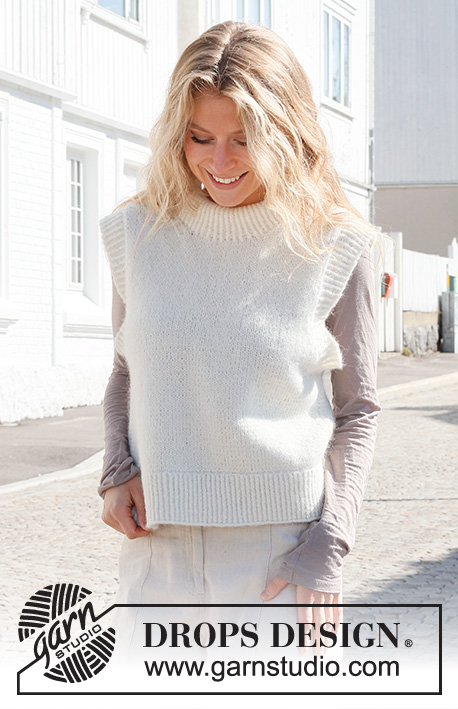 |
||||||
Knitted vest with double neck in DROPS Air. Sizes S - XXXL.
DROPS 227-41 |
|||||||
|
------------------------------------------------------- EXPLANATIONS FOR THE PATTERN: ------------------------------------------------------- RIDGE/GARTER STITCH (worked back and forth): Knit all rows. 1 ridge = knit 2 rows. PATTERN: See diagram A.1. The diagram shows all rows in the pattern from the right side. DECREASE TIP-1 (evenly spaced): To work out how to decrease evenly, count the total number of stitches on needle (e.g. 112 stitches) minus the edge stitches (e.g. 2 stitches) and divide the remaining stitches by the number of decreases to be made (e.g. 32) = 3.4. In this example decrease by knitting together alternately each 2nd and 3rd stitch and each 3rd and 4th stitch (approx.). DECREASE TIP-2 (armholes and neck): All decreases are worked from the right side! DECREASE AT THE BEGINNING OF THE ROW: Work 1 edge stitch in garter stitch, knit 2, slip 1 stitch as if to knit, knit 1 and pass the slipped stitch over the knitted stitch (= 1 stitch decreased). DECREASE AT THE END OF THE ROW: Work until there are 5 stitches left, knit 2 together (= 1 stitch decreased), knit 2 and 1 edge stitch in garter stitch. CASTING-OFF TIP: To avoid the cast-off edge being tight you can cast off with a larger size needle. If the edge is still tight, make 1 yarn over after approx. each 4th stitch at the same time as casting off; the yarn overs are cast off as normal stitches. ------------------------------------------------------- START THE PIECE HERE: ------------------------------------------------------- VEST – SHORT OVERVIEW OF THE PIECE: The back and front pieces are worked separately, back and forth, then sewn together. Ribbed edges are worked around the neck and the armholes to finish. BACK PIECE: Cast on 112-120-132-142-156-170 stitches (including 1 edge stitch on each side) with needle size 3 mm and DROPS Air. Purl 1 row from the wrong side. Then work rib as follows: 1 edge stitch in GARTER STITCH – read description above, work A.1 until there is 1 stitch left, 1 edge stitch in garter stitch. Continue this rib back and forth for 8 cm – adjust so the next row is from the right side. Knit 1 row where you decrease 32-34-38-40-44-48 stitches evenly spaced – read DECREASE TIP-1 = 80-86-94-102-112-122 stitches. Change to needle size 5 mm. Purl 1 row with 1 edge stitch in garter stitch on each side. Continue with stocking stitch and 1 edge stitch in garter stitch on each side. REMEMBER THE KNITTING TENSION! When the piece measures 22-23-24-25-26-27 cm, cast off 4-4-5-5-6-7 stitches for the armholes at the beginning of the next 2 rows = 72-78-84-92-100-108 stitches. On the next row from the right side decrease 1 stitch on each side for the armholes – read DECREASE TIP-2. Decrease like this every 2nd row (each row from the right side) a total of 2-3-3-5-7-8 times, then every 4th row (every other row from the right side) 6-6-7-8-8-9 times = 56-60-64-66-70-74 stitches. When the piece measures 48-50-52-54-56-58 cm, cast off the middle 30-32-34-34-36-36 stitches for the neck from the right side and finish each shoulder separately. LEFT SHOULDER (when the garment is worn): Continue with stocking stitch and 1 edge stitch in garter stitch on each side. AT THE SAME TIME on the next row from the right side decrease 1 stitch at the beginning of the row – remember DECREASE TIP-2 = 12-13-14-15-16-18 stitches. Continue until the piece measures 50-52-54-56-58-60 cm. Loosely cast off with knit from the right side. RIGHT SHOULDER: Continue with stocking stitch and 1 edge stitch in garter stitch on each side. AT THE SAME TIME on the next row from the right side decrease 1 stitch at the end of the row – remember DECREASE TIP-2 = 12-13-14-15-16-18 stitches. Continue until the piece measures 50-52-54-56-58-60 cm. Loosely cast off with knit from the right side. FRONT PIECE: Cast on 112-120-132-142-156-170 stitches (including 1 edge stitch on each side) with needle size 3 mm and DROPS Air. Purl 1 row from the wrong side. Then work rib as follows: 1 edge stitch in garter stitch, work A.1 until there is 1 stitch left, 1 edge stitch in garter stitch. Continue this rib back and forth for 8 cm – adjust so the next row is from the right side. Knit 1 row where you decrease 32-34-38-40-44-48 stitches evenly spaced – remember DECREASE TIP-1 = 80-86-94-102-112-122 stitches. Change to needle size 5 mm. Purl 1 row with 1 edge stitch in garter stitch on each side. Continue with stocking stitch and 1 edge stitch in garter stitch on each side. When the piece measures 22-23-24-25-26-27 cm, cast off 4-4-5-5-6-7 stitches for the armholes at the beginning of the next 2 rows = 72-78-84-92-100-108 stitches. On the next row from the right side decrease 1 stitch on each side for the armholes. Decrease like this every 2nd row (each row from the right side) a total of 2-3-3-5-7-8 times, then every 4th row (every other row from the right side) 6-6-7-8-8-9 times = 56-60-64-66-70-74 stitches. When the piece measures 41-43-44-46-47-49 cm, place the middle 16-18-20-20-22-22 stitches on a thread for the neck, working from the right side, and finish each shoulder separately. RIGHT SHOULDER (when the garment is worn): Continue with stocking stitch and 1 edge stitch in garter stitch on each side. AT THE SAME TIME on the next row from the right side decrease 1 stitch at the beginning of the row. Decrease like this every 2nd row (every row from the right side) a total of 8 times = 12-13-14-15-16-18 stitches. Continue until the piece measures 50-52-54-56-58-60 cm. Loosely cast off with knit from the right side. LEFT SHOULDER: Continue with stocking stitch and 1 edge stitch in garter stitch on each side. AT THE SAME TIME on the next row from the right side decrease 1 stitch at the end of the row. Decrease like this every 2nd row (every row from the right side) a total of 8 times = 12-13-14-15-16-18 stitches. Continue until the piece measures 50-52-54-56-58-60 cm. Loosely cast off with knit from the right side. ASSEMBLY: Sew the shoulder seams inside the cast-off edge. Sew the side seams from the armhole down, inside the 1 edge stitch. DOUBLE NECK: Using circular needle size 3 mm and starting from the right side on the one shoulder, knit up 100-104-112-112-118-118 stitches (including the stitches from the thread) around the neck, inside the 1 edge stitch. The number of stitches should be divisible by 2. Work A.1 in the round for 9-9-9-10-10-10 cm. Cast off with knit over knit and purl over purl – read CASTING-OFF TIP!. Fold the neck double to the inside and sew down. To avoid the neck being tight, it is important that the seam is elastic. SLEEVE-EDGES: Use circular needle size 3 mm and DROPS Air. Start from the right side at the bottom of the armhole and knit up 118-122-126-130-134-138 stitches around the armhole inside the 1 edge stitch. The number of stitches should be divisible by 2. Work A.1 in the round for 4 cm. Cast off with knit over knit and purl over purl – remember CASTING-OFF TIP!. Work the other sleeve-edge in the same way. |
|||||||
Diagram explanations |
|||||||
|
|||||||

|
|||||||
|
Have you made this or any other of our designs? Tag your pictures in social media with #dropsdesign so we can see them! Do you need help with this pattern?You'll find tutorial videos, a Comments/Questions area and more by visiting the pattern on garnstudio.com. © 1982-2024 DROPS Design A/S. We reserve all rights. This document, including all its sub-sections, has copyrights. Read more about what you can do with our patterns at the bottom of each pattern on our site. |
|||||||
With over 40 years in knitting and crochet design, DROPS Design offers one of the most extensive collections of free patterns on the internet - translated to 17 languages. As of today we count 304 catalogues and 11422 patterns - 11422 of which are translated into English (UK/cm).
We work hard to bring you the best knitting and crochet have to offer, inspiration and advice as well as great quality yarns at incredible prices! Would you like to use our patterns for other than personal use? You can read what you are allowed to do in the Copyright text at the bottom of all our patterns. Happy crafting!








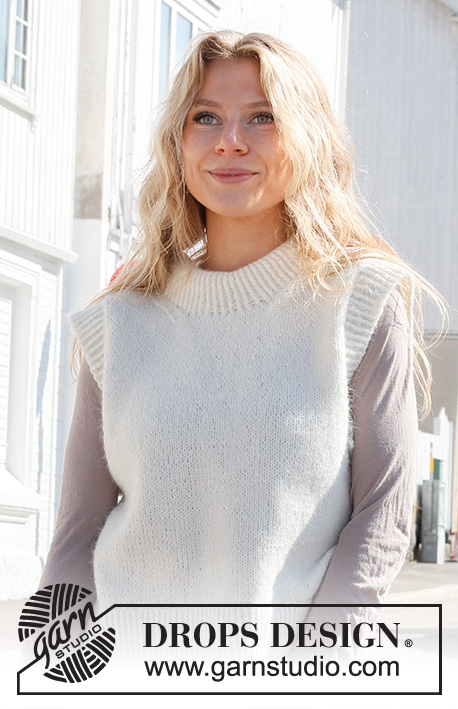
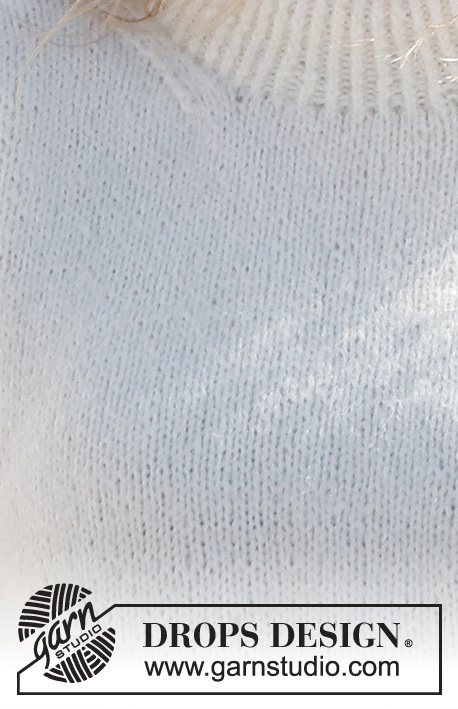



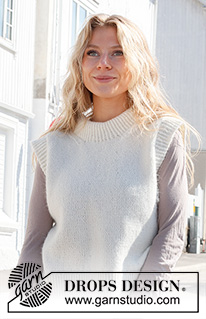
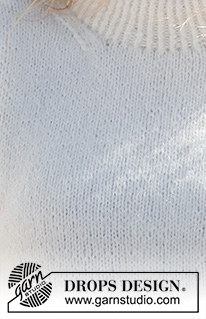





















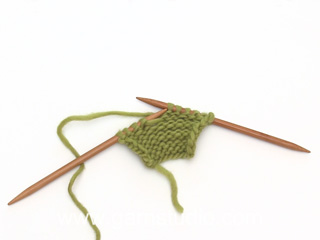




















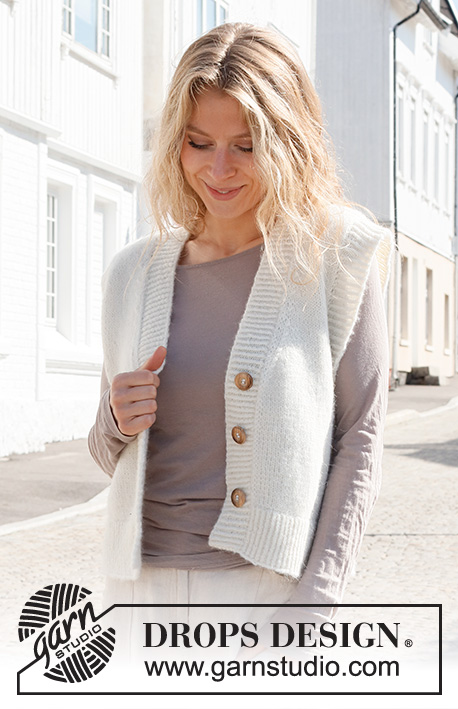






Comments / Questions (14)
Er strikkefastheden i opskriften ud fra pinde str. 3 eller 5?
02.05.2023 - 17:26DROPS Design answered:
Hej Lisa, strikkefastheden er i glatstrik og vi bruger pind 5 :)
03.05.2023 - 07:51Hallo! Ich bin verwirrt. Beim Rückenteil: Muss man nach der Abnahme für die Ärmel (auf bei mir von 78 zu 60 Maschen) einfach normal weiterstricken? Weil ich bin jetzt erst bei 38cm und nicht bei 50cm.🤔 Danke für eine rasche Antwort!
20.01.2023 - 17:18DROPS Design answered:
Liebe Frau Luclaso, wenn alle Maschen für den Ärmelauschnitt abgekettet sind, stricken Sie weiter bis die Arbeit 50 cm (2. Größe) ab der Anschlagskante, dann ketten Sie die mittleren Maschen für den Halsausschnitt und stricken Sie beide Schulter separat zur Ende. Viel Spaß beim stricken!
23.01.2023 - 08:28Hi, I'm a little confused by the decreases on the shoulders of the back piece, as it says 'when the garment is worn'. Is this the point of view of the wearer, or observer?! Are both the decreases (left and right shoulder) done at the centre part of the piece or the edges? Many thanks.
11.04.2022 - 14:07DROPS Design answered:
Dear Jo, when you say "when the garment is worn", the point of view is that from the viewer. These decreases are for the neck, so they are worked towards the neck. Happy knitting!
11.04.2022 - 23:04Se il campione di 17 maglie misura 10 cm, 120 maglia diventano 70 cm non 49. Non mi ritrovo con le misure, potete aiutarmi? Grazie
10.02.2022 - 19:42DROPS Design answered:
Buonasera Michela, quel campione corrisponde alla tensione sul corpo del gilet, quindi deve considerare più o meno il numero delle maglie a partire dalla fine del bordo a coste. Buon lavoro!
10.02.2022 - 19:50Bonjour c'est bien le schéma qui est le même pour le devant et le dos je vous remercie de votre réponse bonne journée cordialement
02.02.2022 - 08:07DROPS Design answered:
Merci pour votre retour, et si vous avez d'autres questions, n'hésitez pas. Bon tricot!
02.02.2022 - 08:18Bonsoir merci pour votre réponse je me suis trompé c'est au sujet du patron je vois le patron du devant mais pas celui du dos c'est le modèle pull sans manche avec col doublé en drops air modèle ai-358 je vous remercie cordialement
01.02.2022 - 17:30DROPS Design answered:
Bonjour Mme Decourtieux, vous pensez au schéma avec les mesures? Il n'y a pas de schéma spécifique pour le dos, c'est le même schéma pour le dos et le devant. Ou bien je comprends encore mal votre question et dans ce cas, je m'en excuse.
02.02.2022 - 07:36Bonsoir j'ai commandé la laine Drops AIR pour le pull sans manches 227-41 j'ai le diagramme du devant je ne vois pas pour le dos je suis perdu pour les diminutions dans l attente d une réponse cordialement
31.01.2022 - 19:39DROPS Design answered:
Bonjour Mme Decourtieux, il n'y a qu'un seul diagramme: A.1 tricoté pour les côtes du bas du dos, du devant, bordure des emmanchures et col. En bas de page, vous retrouvez également le schéma des mesures pour toutes les tailles. À quel diagramme pensez-vous? Pouvez-vous préciser votre pensée? Merci!
01.02.2022 - 08:54Hallo! Ich bin neu dabei mit Kraus-Maschen. Haben Sie irgendwo eine genauere Erklärung wie man A1 versteht, oder wie bei Rück und Hin-Masche in rechts ein vertikales Rippenmusster entsteht?
22.11.2021 - 22:04DROPS Design answered:
Liebe Pina, A.1 besteht aus Rippenmuster 1 Masche rechts verschränkt/1 Masche links, dh bei Hinreihen stricken Sie: *1 Masche rechts verschränkt, 1 Masche links*, von *bis* wiederholen und Reihe mit 1 Masche rechts verschränkt enden (= 1. M in A.1); Rückreihe = 1 Masche links verschränkt, *1 Masche rechts, 1 Masche links verschränkt*, von *-* wiederholen. Viel Spaß beim stricken!
23.11.2021 - 08:27Beautiful and easy help. Knit instructions according to the instructions! And Drops Air
22.10.2021 - 09:06Simplicity slipover
17.08.2021 - 02:01